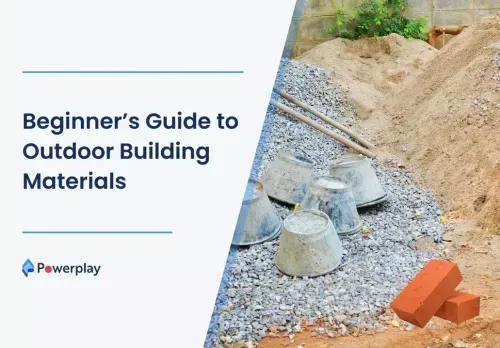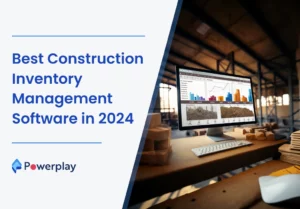Beginner’s Guide to Outdoor Building Materials
-
Kumar Abhishek Anand
- October 11, 2023

Any fresher needs to know about the different types of outdoor building construction materials that are commonly used for almost all building projects. Beginners must be fully familiar with the type of materials they are dealing with so that proper care can be taken while working with materials for building projects. These outdoor construction and building materials generally include house building materials for roofing, cladding, walls, frames, foundations, window and door frames, etc. Every outdoor construction and building material has unique properties that make them suitable for different construction operations and projects. These outdoor building materials are used to construct new buildings or for renovation projects for buildings.

Some of these outdoor building materials may be harmful to human health due to hazards related to them or emissions from them, either during the construction process or during their manufacturing. Some of them may be eco-friendly in nature, procured from sustainable sources, recyclable, reusable, require more or less maintenance in comparison to others, more durable or strong, may be very useful due to the climatic conditions, and many more materials with specific characteristics. Choosing from these construction and building materials is done meticulously based upon suitability to the construction project or operation and by balancing certain factors that may alter the final result of the construction project or task.

The choice of materials made in the initial phase of a project shapes the ideas of the client into reality through these outdoor house-building materials. The materials are selected in a way in which they can prioritize the objectives of the projects and the environmental impact caused by working with them. Some may be chosen because of their sustainable attribute or source, some due to durability or recyclable quotient and the best a beginner can do while choosing from these materials is to be informed about them.
Table of Contents
ToggleConstruction and Building Material Properties
The grounds on which these building construction materials can be sorted and selected are many such as durability, strength, source, impact on the environment, etc. Some of the parameters that need to be considered before choosing an outdoor building construction material have been discussed below:
- Durability- To construct durable buildings, the building blocks or components employed into use must be either durable or add up to provide durability to the structure. Durability can be achieved through efficient use of these outdoor building construction materials, natural durability associated with them or designing them according to the structure to be durable. When we use these outdoor building materials efficiently it is going to last longer than predicted and thus there will be no need to replace them frequently. This not only proves to be lighter on pockets but also beneficial for the environment. Efficient usage of these materials also assists in disposing of them safely when they reach the end of their life. In some situations, these outdoor building materials are used for their natural durability properties such as timbers like larch, cypress, macrocarpa, etc. The potential risks associated with these materials need to be reviewed and eliminated or reduced accordingly. Lastly, some of these building construction materials can be designed in such a way that their durability is enhanced to protect the building from winds, rain, corrosion, etc which in turn ultimately improves the life of the buildings.
- Maintenance- While choosing from an outdoor building materials list there are several factors that need to be considered from a maintenance standpoint. It should be checked whether the material being chosen needs to be protected against moisture, decay or insects by employing methods such as treatments, finishes, coatings, etc. The products being used to protect and maintain these outdoor building materials must be checked if they are potentially harmful to people or the surroundings and in case they are harmful. How to reduce their impact and dispose of them safely. The maintenance frequency needed to maintain the durability of the materials as per the external conditions should also be assessed.
- Sourcing- Locally sourced outdoor building materials can reduce the cost related to the procurement process considerably. Not only there will be less need for transportation of the materials when procured locally but also allows the contractors to see how these materials are manufactured and the way in which they behave in local conditions. This advantage cannot be gained from outdoor building materials that have been imported. While importing building construction materials for a project, essential documents containing environmental impact data must be assessed which convey transparent and comparable information about the environmental impacts of the products made from the outdoor materials throughout the life-cycle of the product.
- Impact of extraction and processing of materials- Every building material has to be either extracted or processed to be made available for use in some way or the other. The extraction and processing of the building construction materials require a certain amount of energy and it is important that this quant of energy used is balanced against energy savings when buildings are constructed from these materials. A material that requires a lot of energy during its extraction or processing operation can help in saving energy throughout the entire life-cycle of a building by reducing energy consumption. This is the reason that the construction and building materials which have been chosen for the project can be either renewable or made from renewable materials so that they can be regenerated and reused. Such materials should be chosen which are biodegradable or fully recyclable, made from recycled materials, sustainable for use, etc.
Types of Outdoor Building Materials
The building materials list for the outdoor construction process includes many natural materials along with artificially designed materials that must be known to any beginner working on a construction site. The building materials list for beginners has been given below:
- Concrete

Concrete is the most important outdoor building material and the most widely used material across the construction industry that must be known by beginners. It is made from a combination of aggregates, sand, cement and water. Portland cement is the most common type of constituent material used for making concrete. Concrete can be poured into a form to be configured into almost any shape. For any building construction, concrete is the most ideal material available because of its versatile nature, cost and unmatched strength. The use of concrete impacts the environment in many severe ways such as a massive carbon footprint left by its usage which is approximately 5% of the emissions emitted worldwide.
- Stone

One of the oldest used building materials over generations in the construction industry is stone. It is available in a wide variety of shapes, sizes, and colors with different strengths that are mostly used based upon their availability near the construction sites as it is not easy to transport them to far distances due to its heavyweight. It can be worked upon efficiently despite its heavy and solid structure. It can not only be used as building blocks for a structure but also for landscaping purposes around buildings for garden retaining walls, walkways, gabions, etc.
- Steel

Steel is being used in massive amounts across the globe for almost all construction projects, mostly in the form of reinforcements. Its strength and durability are above par compared to its counterparts such as wood and stone due to its flexible properties. Stainless steel is specially designed to resist corrosion and oxidation, which makes it more durable.
- Wood

Wood is a generic outdoor building material that is generally used in the form of boards, planks, etc. It is quite flexible under loads, maintaining its strength in bending and far more resistance to vertical compressive stresses. Different quality woods are used to perform respective functions according to their strength parameters. With the increase in building construction, a new type of strong and durable wood known as engineered wood is being used.
- Brick and Block

The most common type of building block that is used in the erection of walls for all kinds of buildings is mainly due to its fire-resisting properties. Bricks are blocks made from clay, which are burnt and baked in kilns and can be of different strengths depending upon the material used and the method used for baking it. It is available in rectangular shapes and 3- 4 standard sizes. In the present times, brick has been mostly replaced by cinder blocks made from concrete and mud.
- Plastic

The revolutionary material plastic has been used even after being more hazardous than advantageous. Plastic is cheap and unsustainable but still has numerous possibilities to be used by recycling into construction materials such as bioplastics. Harder forms of plastic can be used as pipes, shades, lintels, etc because they can be highly resistant to heat and resilient to damage from external agents. It is also used as a building material in the construction industry due to its adaptability, lightweight and uniform composition.
- Glass

Glass is used as clear windows to cover small openings in buildings to achieve transparency and light inside the structures. In present times they are used in facade operations for buildings in great numbers.
Be it any kind of construction, it has to be managed for timely completion and under a fixed budget. Without proper management, any construction project small and large-scaled may go haywire during any stage of the project. To aid contractors and owners in managing construction projects, many software has been developed to be used as management tools for construction projects.
Powerplay application is one such tool that can perform all functions related to construction management right from managing workers’ attendance to equipment and material management until the completion of the project. It can be used easily by almost anybody due to its easy and user-friendly UI.
Share
Kumar is a digital content professional with more than 2 years of experience in Blog writing, copywriting and scripting. His passion lies in the art of creating convincing content that plays a major role in converting leads for SAAS businesses.












